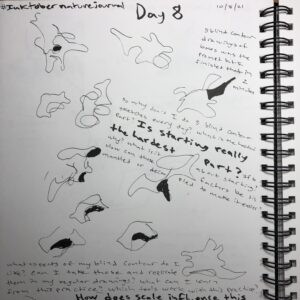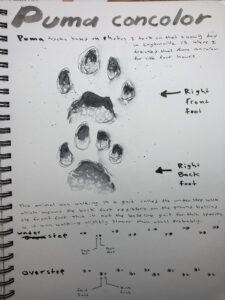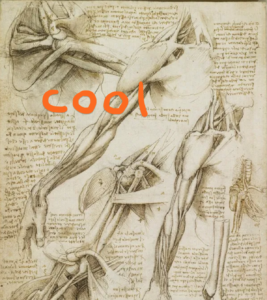Here are the prompts for #inktobernaturejournal week two! Remember, the most important thing is to do a little bit every day. Even if you can only squeeze in a 3 minute entry before sleep. That counts!
Day 8: Five Blind Contour Drawings of Bones
Blind contour drawings and bones are a great match. What is a blind contour drawing? It is a great exercise that improves a number of drawing skills. You draw a subject without looking at your drawing and usually without lifting your pen from paper. First, set up your bones far enough away from your drawing where you can not see them. Next, put your pen down and start drawing. Finally, remember that a blind contour should be fast. There is not much use in adding details since you don’t know where you are.

What are some aspects of your blind contour that you like? How can you apply these to your regular drawings? What can you learn here?
Day 9: Poisonous or Venomous?
Despite the way most people use these words there is indeed a difference. On the other end of the spectrum from how these words are commonly interchangeable there are people who are sticklers about these words always being used correctly. For #inktobernaturejournal we are less concerned about correctness. In fact, we are not even that concerned with pretty pictures. Instead we are focused on consistency and getting an entry for every day of this challenge! This prompt allows you to do some research, be creative in your interpretation. Maybe there is something in your garden or under your sink that matches the prompt? A “joint comparison” could be a good nature journal technique to employ here?
Day 10: Nocturnal Nature Journaling
Did you know that nature doesn’t stop at night? On the contrary, many things in nature only happen at night. If you are never nature journaling at night you are automatically missing half of nature. And between the equinoxes you are missing more than half! For some tips and inspiration check out this video below.
Day 11: Role Reversal in Nature:
I tried to include some prompts like this that allow for your interpretation and creativity. How will you interpret this one? What are some examples of role reversals in nature? What does that even mean to you? Does it say more about how we categorize the world than it does about the world itself? I look forward to seeing your pages when you post them on instagram with the hashtag #inktobernaturejournal. You can also follow me on instagram and tag me.
Day 12: Animal Tracks
Some of you already know that I am really interested in tracking. I got into tracking even before I knew about nature journaling and drawing tracks was one of the main ways that I rekindled my interest in drawing nature. This was the key revelation that resulted in me learning about nature journaling! Drawing tracks is all about seeing and drawing shadows and degrees of shadow. One great ink tool for this is water soluble pen because you can get discrete black spots and lines but you can also create a wash for graded values. I like the Pilot Precise V5 Black Ink: https://amzn.to/2YAuznU



Day 13: Nature Comic
How do you nature journal an exciting event that you witness? How do you capture that hawk catching a rabbit that you witnessed? There are many tools from the world of comics and graphic story telling that we can adapt to nature journaling. Having some tools and experience will allow you to capture these fascinating and fun moments. I will be interviewing Mark Simmons about this specific topic on October 13th on the Nature Journal Show. Don’t miss it! Subscribe and click the bell under the video in the link to get notifications so you always know when I am going live.
Day 14: Dissection or Cross Section
This is a great way to nature journal at home. It is also a great exercise in visual thinking and communication. The easiest thing to do is take a fruit or vegetable (or mushroom) and sketch it while you cut it up. What are the implications of how you cut it to understanding it? What is the best way to show it? I like using button mushrooms, citrus, tomatoes, cabbage etc. Are you feeling more Leonardo DaVinci? If so, you can apply this type of nature journaling to animals. Level one: nature journal a whole chicken or fish you get from the store as you cut it up. Level two: nature journal a fish you catch, a roadkill animal or a dead bird your cat brings in. Level three: take an anatomy class at your local community college and nature journal during the dissections. 
Day 15: Extinct
This one word prompt gives you creative liberty for interpretation. You will probably not be nature journaling from life for this one unless you are looking at fossils or something that is on the verge of extinction. Have fun with this one!
Just getting started with nature journaling?
Need more tips? If so, check out this post. It will walk you through how to nature journal in 10 steps.
Need help choosing nature journaling supplies? Check out Nature Journaling Supplies: What You Need and What You Do Not